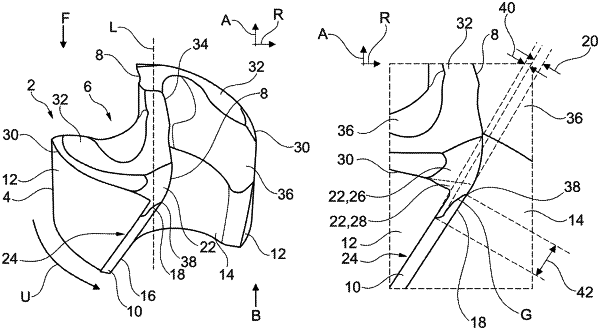| CPC B23B 51/02 (2013.01) [B23P 15/32 (2013.01); B24B 19/16 (2013.01); B23B 2251/122 (2013.01); B23B 2251/14 (2013.01); B23B 2251/201 (2013.01); B23B 2251/44 (2013.01); B23B 2251/446 (2013.01)] | 9 Claims |

|
1. A method for producing a drill, the drill comprising a body extending along a longitudinal axis (L) from a rear side (B) to a front side (F), wherein the body comprises a main cutting edge on the front side (F), wherein the body comprises a guide bevel, which extends in an axial direction (A) toward the front side (F) along a secondary cutting edge, wherein, toward the front side (F), the guide bevel has an end section which is tapered as a result of a first free surface directly adjacent the guide bevel in the axial direction (A), wherein the drill has a smaller diameter (D) on the first free surface than on the guide bevel, wherein the first free surface comprises two partial surfaces, namely an axial surface, which extends on a side of the body along the end section, and a radial surface, which extends on the front side (F) such that the first free surface as a whole is curved, and wherein the radial surface extends along the main cutting edge and follows the main cutting edge in a direction of rotation (U), the method comprising:
grinding the end section of the guide bevel such that the axial surface of the first free surface has a width that is constant such that an imaginary boundary line (G) between the guide bevel and the first free surface extends parallel to the guide bevel.
|